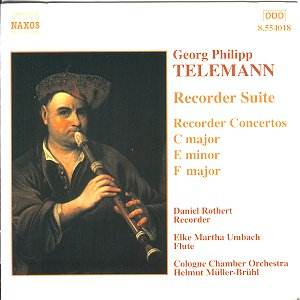Telemann seems to have had something of an affinity
for the recorder. His settings are extensive and irreproachably effective.
Virtuosity and lyricism co-exist with rich and varied stylistic procedures
and a pan-European musical sensibility. He clearly had at his disposal
players of the utmost virtuosity because these are works that make the
highest demands on the performers’ techniques and on this disc, in the
person of Daniel Rothert – who also wrote the notes – Telemann is well
served. The A minor Suite opens with an Overture in the French style
followed by explicitly Italian development and Les Plaisirs, the second
movement, is delightfully robust. Rothert only plays in the central
section here, surrounded as he is by pointed and rhythmically alive
string panels. The orchestra by the way is Hermann Abendroth’s 1923
creation and Muller-Bruhl has now conducted it for nearly forty years
- for a decade they played on period instruments as the Capella Clementina
but since 1987 they have played exclusively on modern instruments and
their discretion and sensitivity are noticeable. The third movement
is an Italian aria, of the type familiar from Handel’s Italian operas,
and deliciously vocal. As the Suite progresses one can admire the soloist’s
secure intonation, the prominent harpsichordist and the accurate line
of the strings. The final movement, a Polish dance – Telemann got around
a bit geographically – ends with a splendidly realised and performed
quiescent flourish.
The C major concerto is a skilful mélange of
technical and expressive devices. It is distinctly Vivaldian and exploits
internal contrasts to advance the musical argument. I admired the care
and emphasis with which the performers asserted the differences in dynamics
between the soloist and the orchestral tuttis as I did the apportioning
of solo and tutti passages in the tempo di Minuet finale. Rothert is
athletic, articulate and accurate. The E minor Double Concerto is written
for recorder and transverse flute – uniquely – and features some delightful
phrase-chasing in the second movement Allegro as well as unison passages
over a now-sturdy, now-light orchestral accompaniment. The Largo has
affectionate weight with orchestral pizzicatos and the Flute and Recorder
duetting high above like larks. The F major Concerto hearkens back to
the Italian ritornello and preserves an individuality of utterance distinct
from the other works, a characteristic of this multi talented composer.
The rapidity of the articulation in the Allegro contrasts with the simple
and short Adagio in a virtuosic but unpretentious work.
Telemann’s fecund muse will doubtless always be underestimated
– but for those in the know there are always pleasures galore to be
had from absorbing and enjoying his seemingly limitless capacity to
synthesise styles in his own inimitable and infectious form.
Jonathan Woolf


